Spain Satellite Imagery Services Market Size
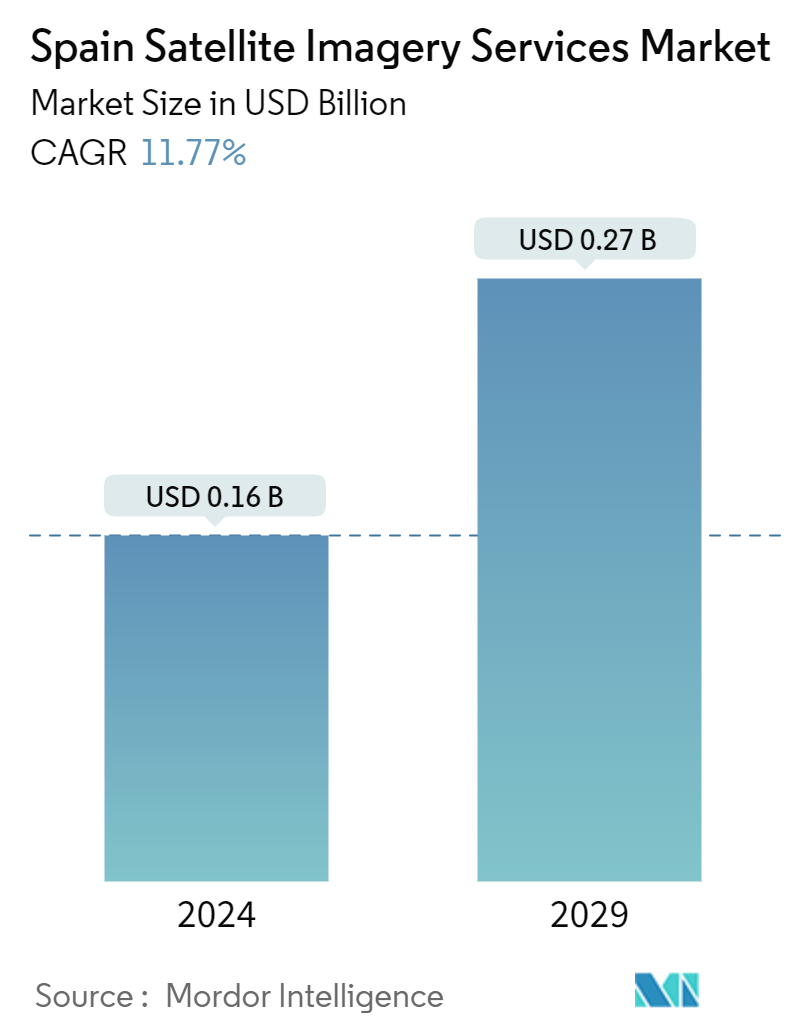
| Study Period | 2019 - 2029 |
| Base Year For Estimation | 2023 |
| Market Size (2024) | USD 0.16 Billion |
| Market Size (2029) | USD 0.27 Billion |
| CAGR (2024 - 2029) | 11.77 % |
| Market Concentration | Medium |
Major Players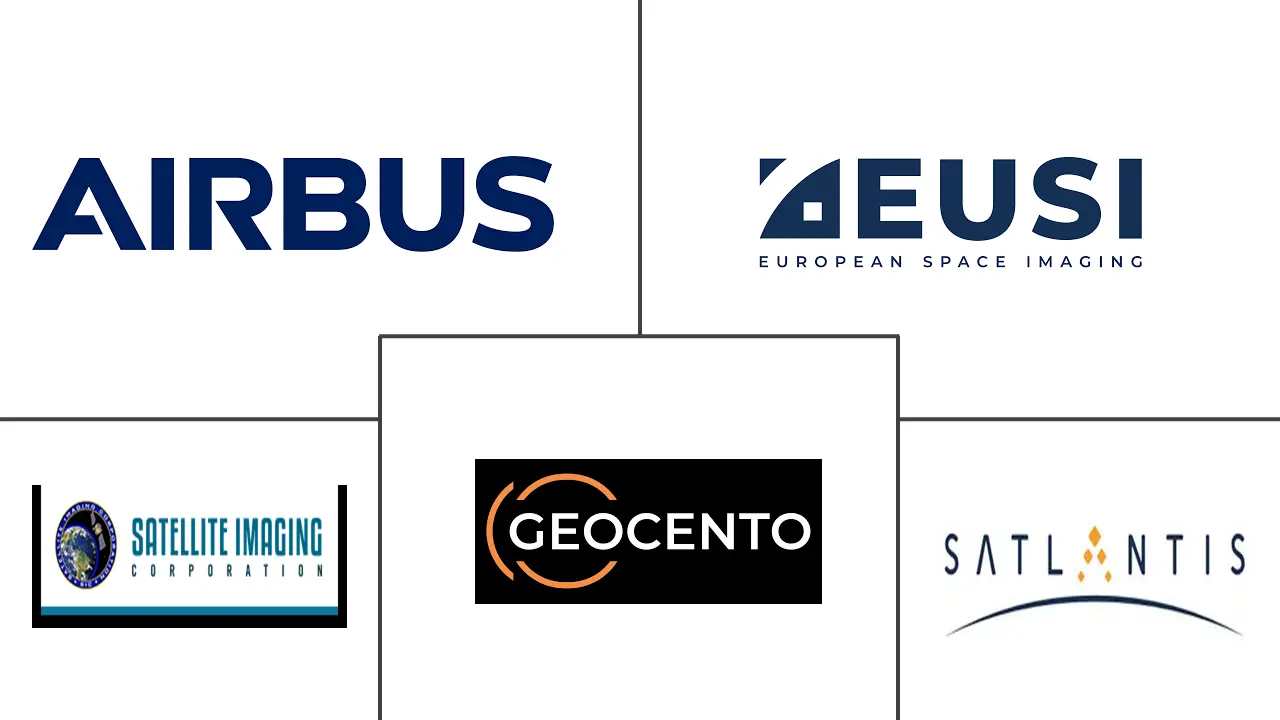
*Disclaimer: Major Players sorted in no particular order |
Spain Satellite Imagery Services Market Analysis
The Spain Satellite Imagery Services Market size is estimated at USD 0.16 billion in 2024, and is expected to reach USD 0.27 billion by 2029, growing at a CAGR of 11.77% during the forecast period (2024-2029).
Growing concerns about climate change, environmental degradation, and disaster monitoring are driving up demand for satellite imagery services in the country. Furthermore, governments raise their defense budgets as security concerns and geopolitical conflicts between countries develop. They're using commercial satellite photography to give data that will assist them in improving defense and security operations. Satellite imaging also offers information on the planet's chemical, physical, and biological aspects.
- The advent of autonomous cars led to advancements in image maps, which may soon transform into HD maps with extreme accuracy (ideally below 10 cm). Thus, companies that provide mapping services and products invest in developing these HD maps. With the rollout of these maps, the application of commercial satellite imaging is likely to be expanded to the transportation industry.
- Furthermore, the proliferation of new mobile geospatial sensor platforms, coupled with the rapid miniaturization of technologies, led to the development of small satellites (smallsats), which can be easily designed and deployed. Technological advancements in space 3D printing, electronic components miniaturization, advanced material technology, artificial intelligence (AI), and machine learning will likely assist manufacturers in space.
- Remotely sensed satellite images and data include spatial and temporal resolutions. Spectral statistics involve elements of remotely sensed image classification. The temporal resolution allows for generating land cover maps (for environmental planning, land use change detection, and transportation planning) and data integration and analysis of urban areas using medium-resolution remote sensing imagery.
- This mode mainly focuses on the documentation of built-up areas and is used to differentiate between residential, commercial, and industrial zones. Moreover, location-based services are extensively used in emergency and disaster management, as coordinating emergency management procedures with location-awareness activities is paramount.
- The players in the market are developing new solutions to expand their market share. For instance, in September 2022, ICeye, the Finnish owner of the world's largest synthetic-aperture radar (SAR) satellite constellation, teamed up to develop and build a new generation of satellites that combine radar and optical imaging in Spain. It is operating with Satlantis to manufacture four satellites for a new constellation in low earth orbit called Tandem for Earth Observation (Tandem4EO). This will consist of two radar and two VHR optical satellites with a resolution of under 1m.
- The aerial and terrestrial imaging solutions pose a significant challenge to the growth of the market studied, as they provide better resolution than satellite imaging. In addition, the inability of satellites to work in adverse weather conditions, such as fog, snow, and cloud cover, also restricts the market growth. Aerial imaging can be carried out under cloud cover, with minor corrections to be applied during post-processing. This guarantees cloud-free data delivery. Due to low altitude acquisition, aerial data does not suffer from atmospheric effects, which can impact the quality of the data in satellite imagery.
Spain Satellite Imagery Services Market Trends
Surveillance and Security is Expected to Hold Significant Share
- Satellite imagery and GIS systems allow security and law enforcement agencies to identify hot spots and other trends and patterns for crime mapping. Accurate detection of spatial concentrations of crime and timely mapping of crime locations help law enforcement identify the concentration of crimes in space and time, thus, providing important information for crime reduction efforts. Such imagery helps provide efficiency and speed of analysis in this application area by allowing analysts to overlay other datasets, such as census demographics and locations of stores, banks, and schools. This helps security department administrators understand the underlying causes of crime and devise strategies. These strategies include allocating police officers and dispatching them to emergencies.
- However, there is an increase in demand for advanced remote sensing techniques, which can provide colour and panchromatic image processing services, along with the ability to sharpen the image with data fusion, enhancements, georeferencing, mosaicing, and colour/grayscale balancing. Furthermore, various prototype systems are being developed to detect and view crime hotspots in a web environment, using thematic layers overlaid on background data.
- Hotspot mapping techniques, such as choropleth mapping, grid mapping, spatial ellipse mapping, and kernel density mapping, are being implemented to map crime hotspots, predict future crime locations, and optimize crime reduction efforts. Satellite imaging allows alarm and video surveillance systems to be connected to security centres via satellite. Alarm messages and live video images can both be sent at the same time. The video images can be used for surveillance or alarm verification. Emergency voice conversations and remote control of devices such as cameras were made possible through bidirectional audio and internet-like data channels.
- Space democratization is already taking place. The development of space and satellite technology, as well as the availability of this technology to countries, organizations, and individuals, has accelerated in the twenty-first century. Due to technological advancements, large, expensive capabilities can now be housed on smaller, lighter, and less expensive platforms. The use of generated satellite images for various industries across diverse economic sectors, as well as a broad range of new applications, lower technology barriers, and the emergence of SMEs and startups in the imagery analytics market, brought a large-scale diversity to the market studied.
- According to NATO, in 2023, Spain's defence expenditure was estimated at USD 19,179 million. Such figures turned Spain into the country with the seventh highest defence expenditure among NATO members. Spain must embrace this democratization of space and shift away from large, expensive military-centric space platforms in favour of less expensive, more inventive technologies and better commercial options.
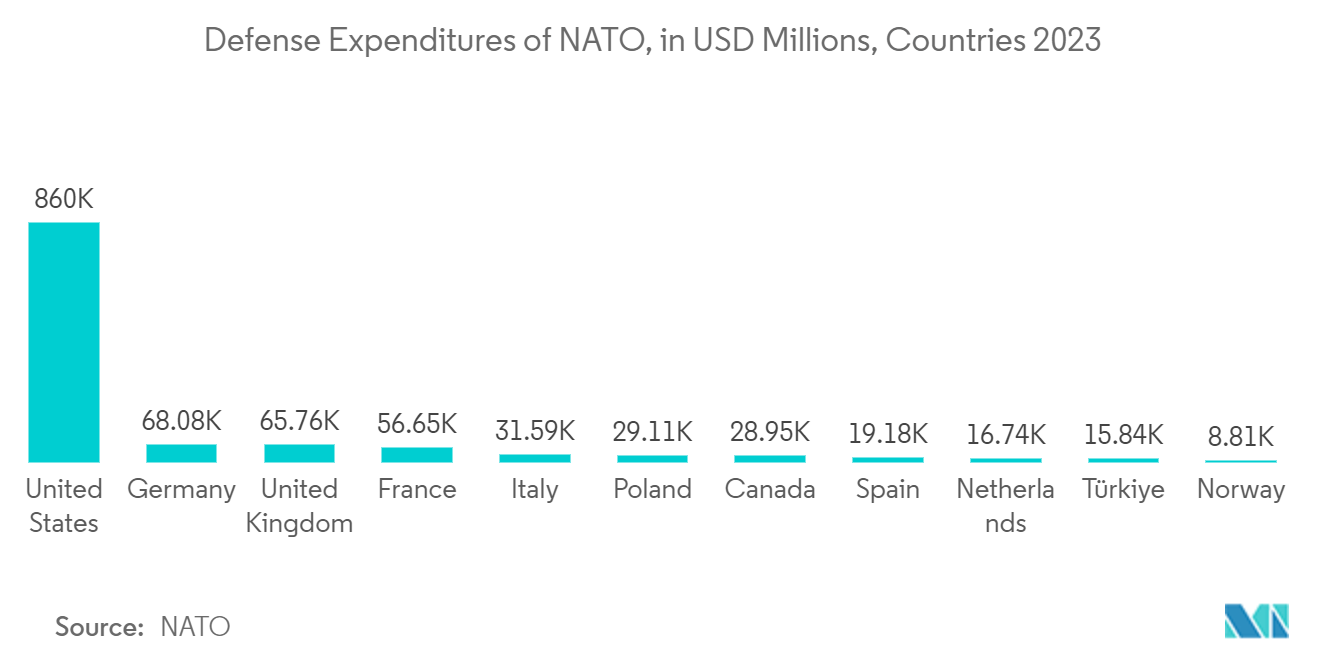
Transportation and Logistics is Expected to Hold Significant Share
- Transportation and logistics providers are one of the earliest adaptors of commercial satellite imagery. Almost all railway networks and public transportation systems worldwide utilize commercial satellite imaging data for monitoring and planning. Many logistics providers worldwide provide live tracking facilities as a value-added service to goods manufacturers to ensure positive consumer sentiment and minimal damage during transit. This trend has been rising, mainly due to increased activity in the global e-commerce industry. Furthermore, the increasing cross-border logistics and last-mile deliveries are creating a great need for transportation and logistics companies to plan routes before the departure of goods, to make the best of the live traffic, weather, and road conditions.
- Space data is currently being implemented in transport systems. For example, hazardous goods transported by unpowered assets were being tracked and monitored using satellite data, as it is extremely difficult to monitor them in real-time. Certain parameters are being monitored, ensuring safe and reliable journeys. Other areas include winter road maintenance and intelligent cargo monitoring. By utilizing satellite navigation and imaging technology, one can control winter maintenance without requiring manual intervention. Both these technologies can provide cost-effective ways of monitoring and controlling the supply chain of high-value containers.
- Advances in technology and the availability of geospatial information help transportation and logistics planners use data and analyze it more efficiently. Geospatial technology also helps logistics drivers visualize garage locations and fueling stations nearby. As transportation and logistics companies are looking for cost-effective solutions to optimize their fleet operations, geospatial information is helping them by providing information related to road conditions and traffic congestion. Moreover, newer remote sensing technologies, such as high-resolution satellite imagery, extract terrain elevations, create contour maps, and locate infrastructure assets like road centerlines, bridges, culverts, signs, and overpasses.
- According to the Ministry of Transport, Mobility and Urban Agenda (Spain), In July 2022, only 42 public companies in Spain had more than 60 authorized light commercial vehicles. In total, the number of public road freight transport companies with authorization to use this type of commercial vehicle amounted to approximately 55,900. Such a huge number of public transport vehicles in the region would create an opportunity for the studied market to grow.
- As the market continues to evolve, significant firms worldwide are increasingly relying on technologies such as machine learning and artificial intelligence (AI) to scan daily satellite imagery, detect and classify items, and track even minor changes. Artificial intelligence (AI) primarily helps extract valuable insights from the rapidly growing satellite imagery, thus presenting solid AI-driven data analytics for various applications. Technologies like machine learning offer better clarity and visualization by interpreting the images from different vantage points. Artificial intelligence (AI) primarily enables extracting valuable insights from rapidly growing commercial satellite imagery.
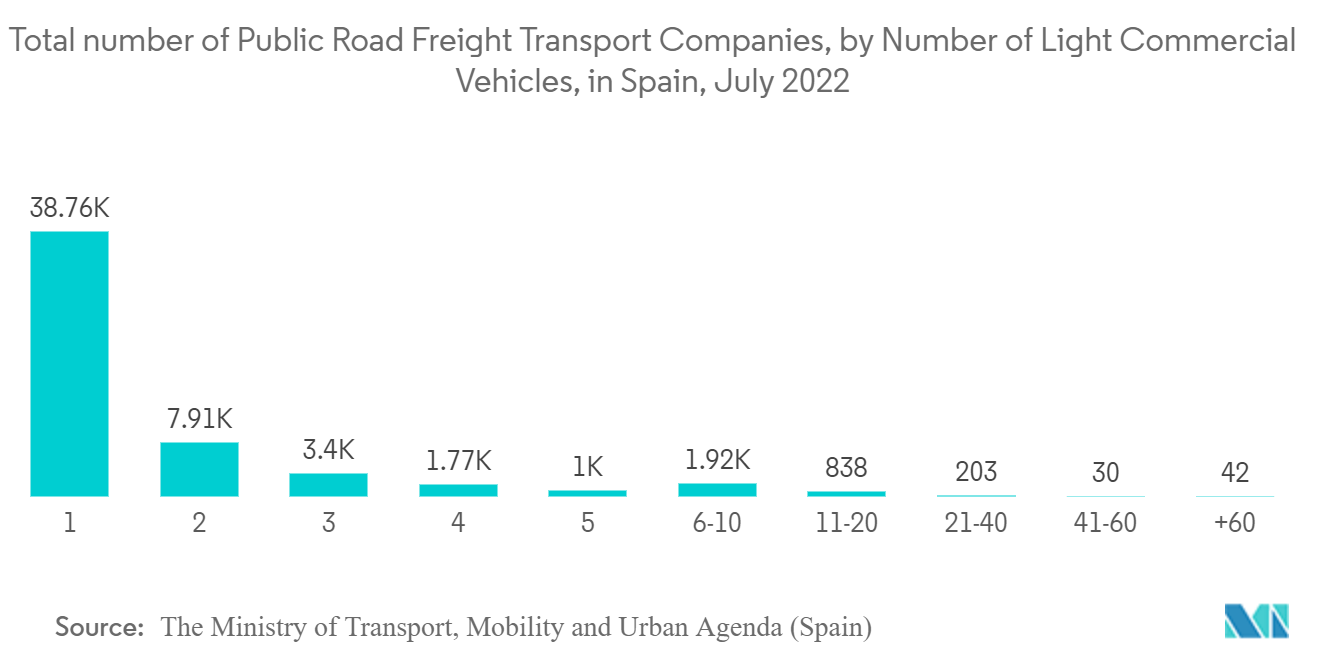
Spain Satellite Imagery Services Industry Overview
The Spain Satellite Imagery Services market is moderately consolidated with several players like Geocento, Satlantis, European Space Imaging (EUSI) GmbH, Airbus SE etc. The companies continuously invest in strategic partnerships and product developments to gain substantial market share. Some of the recent developments in the market are
In April 2023, BlackSky Technology Inc. reseller Telespazio Ibérica will deliver Spain's first-ever high-cadence, low-latency rapid emergency imagery service to the Government of Aragon and the Geographic Institute of Aragon (IGEAR). The autonomous community of Aragon will use the imagery service to streamline responses to various crisis situations, including fires, floods, and other natural disasters.
In April 2023, Spanish Earth observation satellite provider Satlantis bought a majority stake in British university spin-out SuperSharp to expand into the thermal imaging market. SuperSharp is developing a foldable thermal infrared telescope that would enable satellites as small as 12U, or the size of 12 cubesats, to provide images with a 6-meter ground sampling distance. Satlantis currently develops Earth imaging payloads using high-resolution visible (VIS), near-infrared (NIR), and short-wave infrared (SWIR) spectra. Adding SuperSharp's technology to its product mix enables Satlantis to offer payloads across a full spectrum of imaging solutions from the visible and near-infrared (VNIR) portion of the electromagnetic spectrum to long-wave infrared (LWIR).
Spain Satellite Imagery Services Market Leaders
-
Satellite Imaging Corporation
-
Geocento
-
Satlantis
-
European Space Imaging (EUSI) GmbH
-
Airbus SE
*Disclaimer: Major Players sorted in no particular order
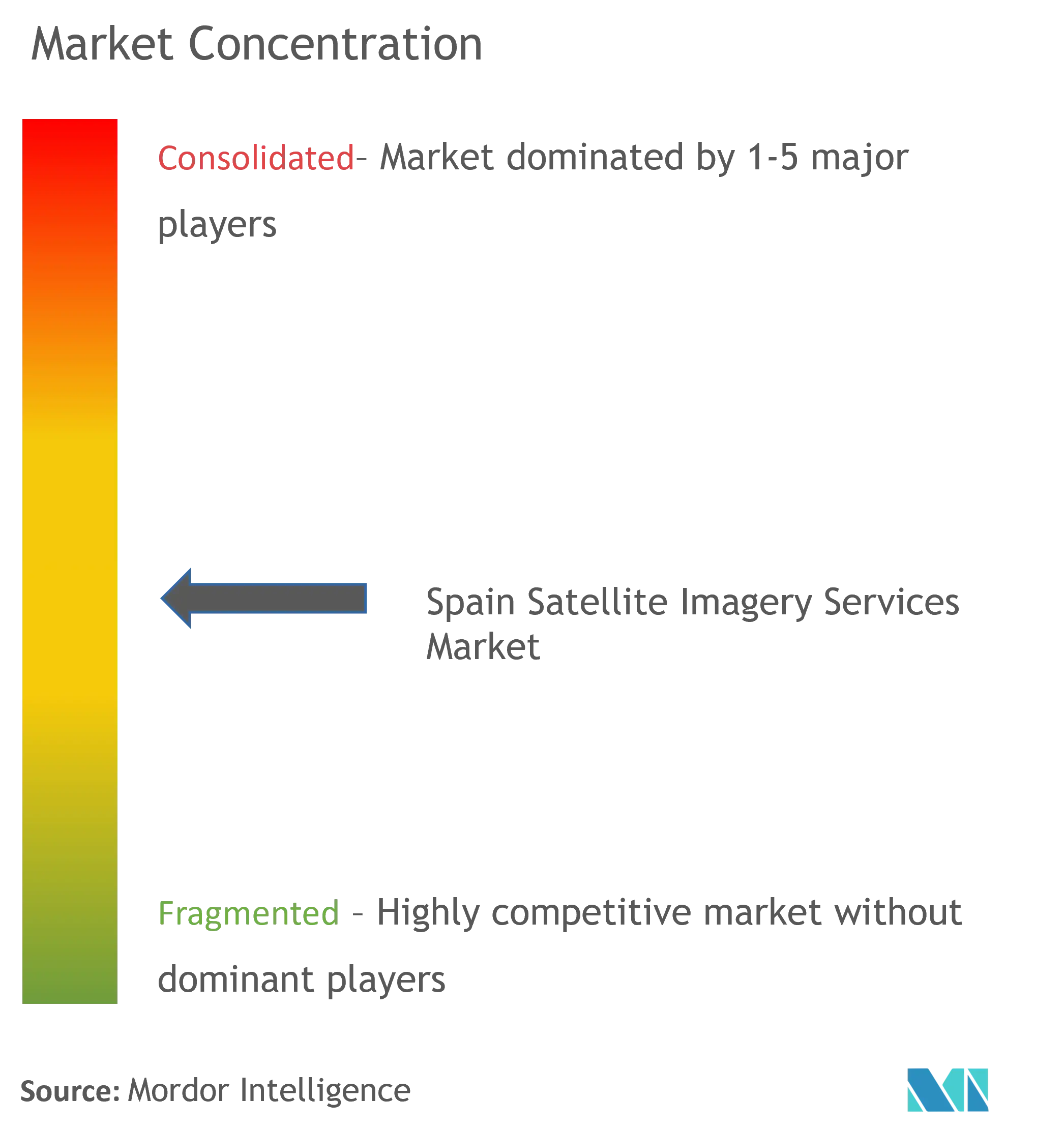
Spain Satellite Imagery Services Market News
- July 2023: Maxar Technologies, a provider of comprehensive space services and secure, precise geospatial intelligence, announced the initial release of its new Maxar Geospatial Platform (MGP), enabling fast and easy access to the world's most advanced Earth intelligence. MGP will simplify geospatial data and analytics discovery, purchasing, and integration.MGP users will have access to Maxar's industry-leading geospatial content, including high-resolution satellite imagery, stunning imagery base maps, 3D models, analysis-ready data, and image-based change detection and analytic outputs.
- September 2022: Planet added another type of imagery satellite to its product line, the latest development of the firm's data-gathering operations. The company called the new satellites Tanager -- named after a bird family like the current lines of Dove and Pelican satellites it manufactures. But unlike those satellites, which have cameras and detectors capturing images in the same range as the human eye, the Tanager satellites will capture 'hyperspectral' imagery, separating the light spectrum into hundreds of bands of light.
Spain Satellite Imagery Services Market Report - Table of Contents
1. INTRODUCTION
- 1.1 Study Assumptions and Market Definition
- 1.2 Scope of the Study
2. RESEARCH METHODOLOGY
3. EXECUTIVE SUMMARY
4. MARKET INSIGHTS
- 4.1 Market Overview
-
4.2 Industry Attractiveness - Porter's Five Forces Analysis
- 4.2.1 Bargaining Power of Buyers
- 4.2.2 Bargaining Power of Suppliers
- 4.2.3 Threat of New Entrants
- 4.2.4 Threat of Substitutes
- 4.2.5 Intensity of Competitive Rivalry
- 4.3 Industry Value Chain Analysis
- 4.4 Assessment of the Impact of COVID-19 on the Market
5. MARKET DYNAMICS
-
5.1 Market Drivers
- 5.1.1 Increasing Adoption of Location-based Services
- 5.1.2 Satellite data usage is increasing
-
5.2 Market Restraints
- 5.2.1 Strict government regulations
- 5.2.2 High-resolution Images Offered by Other Imaging Technologies
6. MARKET SEGMENTATION
-
6.1 By Application
- 6.1.1 Geospatial Data Acquisition and Mapping
- 6.1.2 Natural Resource Management
- 6.1.3 Surveillance and Security
- 6.1.4 Conservation and Research
- 6.1.5 Disaster Management
- 6.1.6 Intelligence
-
6.2 By End-User
- 6.2.1 Government
- 6.2.2 Construction
- 6.2.3 Transportation and Logistics
- 6.2.4 Military and Defense
- 6.2.5 Forestry and Agriculture
- 6.2.6 Others
7. COMPETITIVE LANDSCAPE
-
7.1 Company Profiles
- 7.1.1 Satellite Imaging Corporation.
- 7.1.2 Geocento
- 7.1.3 Satlantis
- 7.1.4 European Space Imaging (EUSI) GmbH
- 7.1.5 Airbus SE
- 7.1.6 Head Aerospace Group
- 7.1.7 Planet Labs PBC
- 7.1.8 Galileo Group Inc.
- 7.1.9 Hexagon AB
- 7.1.10 Maxar Technologies Inc.
- *List Not Exhaustive
8. INVESTMENT ANALYSIS
9. MARKET OPPORTUNITIES AND FUTURE TRENDS
** Subject To AvailablitySpain Satellite Imagery Services Industry Segmentation
Satellite imagery refers to images of the Earth taken from satellites orbiting the planet. These satellites are equipped with various sensors for detecting visible light, infrared light, microwave radiation, and more to craft high-resolution images. These images combine to create visual representations of the Earth that provide new perspectives on climate, geography, and manmade structures.
The Spain satellite imagery services market is segmented by application (geospatial data acquisition and mapping, natural resource management, surveillance, and security, conservation, and research, disaster management, intelligence), by end-user (government, construction, transportation, and logistics, military and defense, forestry, and agriculture).
The market sizes and forecasts are provided in terms of value (USD) for all the above segments.
| By Application | Geospatial Data Acquisition and Mapping |
| Natural Resource Management | |
| Surveillance and Security | |
| Conservation and Research | |
| Disaster Management | |
| Intelligence | |
| By End-User | Government |
| Construction | |
| Transportation and Logistics | |
| Military and Defense | |
| Forestry and Agriculture | |
| Others |
Spain Satellite Imagery Services Market Research Faqs
How big is the Spain Satellite Imagery Services Market?
The Spain Satellite Imagery Services Market size is expected to reach USD 0.16 billion in 2024 and grow at a CAGR of 11.77% to reach USD 0.27 billion by 2029.
What is the current Spain Satellite Imagery Services Market size?
In 2024, the Spain Satellite Imagery Services Market size is expected to reach USD 0.16 billion.
Who are the key players in Spain Satellite Imagery Services Market?
Satellite Imaging Corporation, Geocento, Satlantis, European Space Imaging (EUSI) GmbH and Airbus SE are the major companies operating in the Spain Satellite Imagery Services Market.
What years does this Spain Satellite Imagery Services Market cover, and what was the market size in 2023?
In 2023, the Spain Satellite Imagery Services Market size was estimated at USD 0.14 billion. The report covers the Spain Satellite Imagery Services Market historical market size for years: 2019, 2020, 2021, 2022 and 2023. The report also forecasts the Spain Satellite Imagery Services Market size for years: 2024, 2025, 2026, 2027, 2028 and 2029.
Spain Satellite Imagery Services Industry Report
Statistics for the 2024 Spain Satellite Imagery Services market share, size and revenue growth rate, created by Mordor Intelligence™ Industry Reports. Spain Satellite Imagery Services analysis includes a market forecast outlook to for 2024 to 2029 and historical overview. Get a sample of this industry analysis as a free report PDF download.



